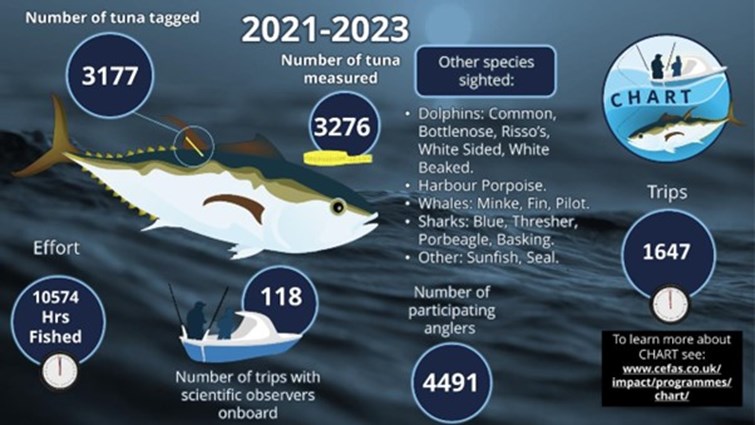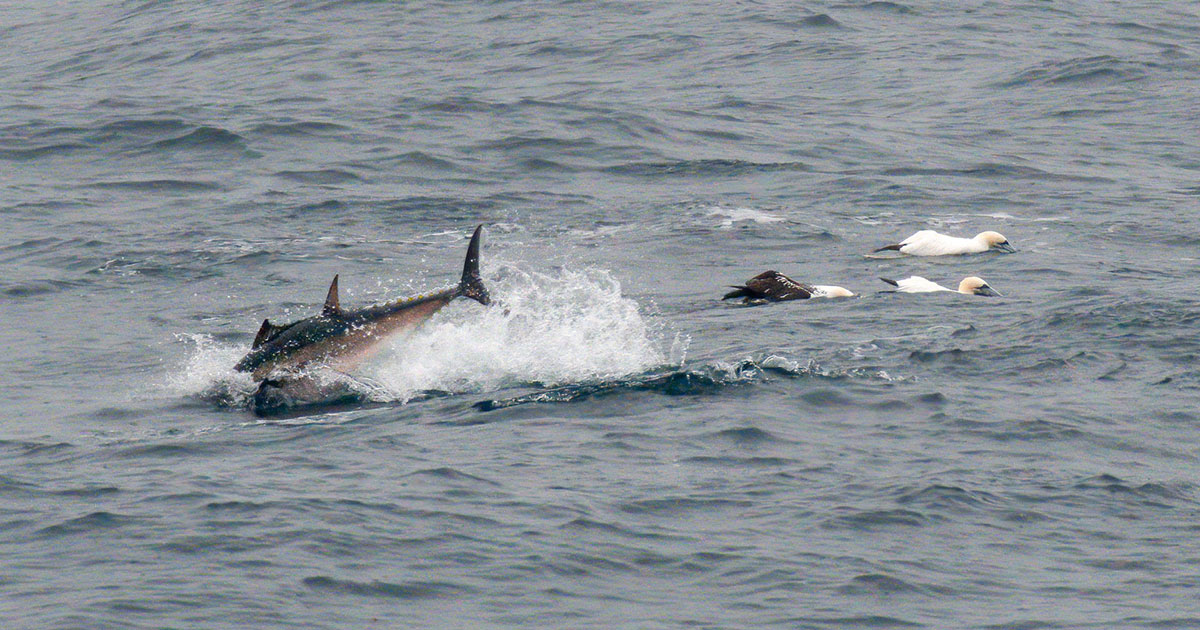A three-year research program, co-designed by scientists, policymakers, recreational anglers, skippers and conservationists, to unlock understanding of Bluefin Tuna (BFT) populations in English waters has been deemed a success or a “once in a lifetime opportunity” to understand these remarkable top predators; leaving a valuable legacy of high welfare standards and professional skills to inform a future sustainable recreational BFT fishery, in addition to bringing economic benefits to coastal communities.
In addition to providing important scientific data, Catch and Release Tagging Program (CHART) brought valuable economic benefits to coastal communities, by attracting recreational anglers to engage with this iconic sportfish and boosting local tourism. A socio-economic survey of participating anglers and skippers was conducted in 2022, enabling Cefas (Centre for Environment Fisheries and Aquaculture Science) to estimate the Program’s economic impact. Based on the survey responses from participating anglers, 80% of the spending from anglers was local and generated a total economic impact of £2.6 million, providing £733k of Gross Value Added (GVA) and supporting approximately 34 full-time employment (FTE) positions bringing in much needed income to local coastal economies within South-West of England.
Participants of the Defra funded CHART Program, reunited last month in Plymouth for a final workshop to share the overall achievements of this ambitious project, including a report published on the Cefas website outlining the impact of CHART, all of which have helped to inform Government decision making in support of a new recreational catch and release fishery in UK waters.
Following a growing UK interest in BFT from the science community, the recreational fishing community, and the commercial fishing sector, consultation between stakeholders began in 2020, resulting in co-designed CHART program for BFT which was piloted in English waters in 2021. The purpose of the program was to gather scientific information about BFT, the benefits of a catch and release program and to improve the science and management of BFT in English waters.
For the first time ever, this program allowed 15 charter skippers to take paying anglers out to catch BFT legally in UK waters. In 2022 and 2023 CHART was expanded to include 25 charter vessels, operating from mid-August to mid-December. The Plymouth workshop highlighted the enormous achievement of all involved over the three-year period. In total, 3,177 tags were deployed, 1,655 trips were made, and 4,490 anglers were able to realize their tuna fishing ambitions.
 (Image credit: Cefas)
(Image credit: Cefas)
The reunited skippers and crew took the opportunity to share their experiences and insights of the project. All acknowledged the unique opportunity to acquire scientific knowledge and develop specialist professional skills to catch and release Bluefin tuna safely and humanely. As a result of CHART, a highly motivated community of interest was formed, comprising 126 professionally trained individuals, working together to meet exceptionally high welfare standards. Over the duration of the project 99.3 % of BFT were released alive—widely viewed by sector experts, as an exceptionally low mortality rate.
Dr. David Righton, CHART Principal Investigator said: “The CHART project has generated a valuable and robust scientific dataset that provides us with valuable evidence about the Bluefin Tuna population in waters of the UK, as well as a deep understanding of how professional charter skippers and their crew interact with and care for the creatures that they target. The outputs of the project will help to define the standards for a high-welfare, sustainable Bluefin Tuna recreational fishery in future.”
Joanna Ford, CHART Operations Manager for the duration of the project said: “Working alongside the skippers, crews, government bodies and industry stakeholders to bring this project to fruition has been the most challenging but most rewarding project I've had the pleasure of being part of.”
Reflecting on his experience of the project, one of the CHART participants commented: “Being part of CHART has been a once-in-a-lifetime opportunity. As an experienced fisherman and angler, it has been a childhood dream to be able to catch these incredible fish in local waters. This project has been so much more than fishing and I have learnt so much more than I expected, both about fishing and catching tuna, but also science, government and the power of working together. The training that Cefas provided has allowed me to work with others and highlighted how we can all continue to learn every day.”
With the end of the 2023 season, came the end of CHART following the recent announcement of a recreational catch and release fisheries in UK waters expected to be in place by summer 2024. This announcement was driven by the overwhelming success of CHART and the value of the data provided. The success of this program is a testament to the collaboration of scientists, policymakers, recreational anglers, skippers, crews, and conservationists working towards a mutual objective to improve the scientific understanding and management of bluefin tuna.



